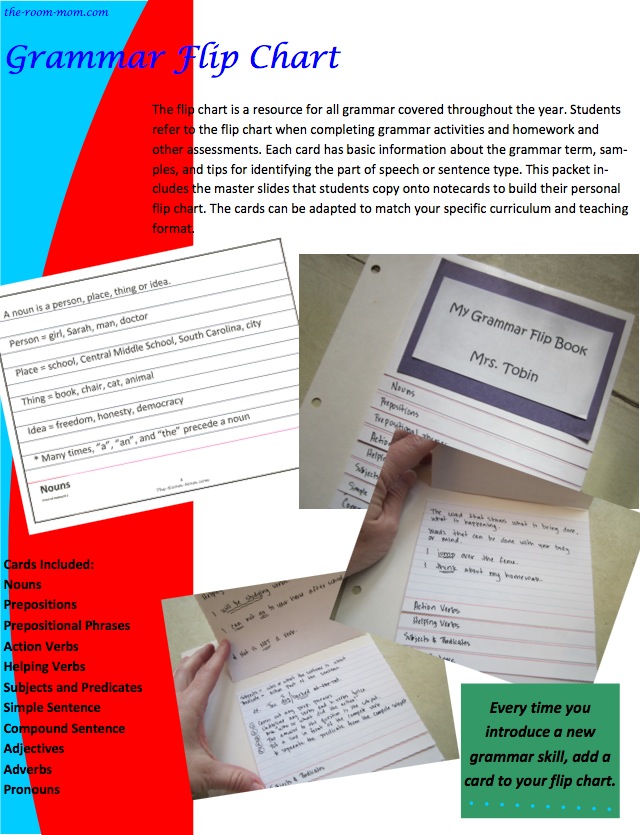As I mentioned in yesterday's post, my parts of speech instruction (which we call POS for short) is limited to one sentence per day. This simple system, which I've used for many years, helps students understand each word's function in the sentence. The first week of school we review nouns and verbs, subjects and predicates. The sentences are really short at this point (e.g., "Dogs may bite," or "Caterpillars become butterflies.") The sentences grow each week as new parts of speech are introduced. Daily analysis and discussion promote higher order thinking skills and build a powerful spiral of grammar skills.
This year, I'm going to improve my program! Each time I introduce a new part of speech, my students will add it to their handy Grammar Flip Books, which I am purchasing from The Room Mom. I can't wait to try these in my classroom; the kids will love it!
- L.4.1a Use relative pronouns (who, whose, whom, which, that) and relative adverbs (where, when, why).
- L.4.1d Order adjectives within sentences according to conventional patterns (e.g., a small red bag rather than a red small bag).
- L.4.1e Form and use prepositional phrases.
- L.4.1g Correctly use frequently confused words (e.g., to, too, two; there, their).
That leaves us with three more things to teach:
- L.4.1b Form and use the progressive (e.g., I was walking; I am walking; I will be walking) verb tenses.
- L.4.1c Use modal auxiliaries (e.g., can, may, must) to convey various conditions.
- L.4.1f Produce complete sentences, recognizing and correcting inappropriate fragments and run-ons.
After teaching all of this stuff, you'll need to have a way to assess your students' progress. I'd like to suggest 4th Grade Common Core Language Assessment from Teaching and Tapas. This product contains one- and two-page assessments for every fourth grade CCSS skill (20 in all!)
For Inquiring Minds Who Want to Know More
And now, for those of you who want to know how to compact parts of speech instruction to just one sentence per day, please read on to find out more about my POS unit. As I said, I've used this system for many years. My students benefit in two ways: greater understanding of parts of speech and more time for writing in the classroom.
I'll share what I do week by week, emphasizing the skills necessary for meeting the Common Core State Standards. You are welcome to use all and any of my ideas to create your own weekly POS unit, but if you're looking for a ready-made unit, you can find Parts of Speech: Rigorous Pace in my Teachers pay Teachers store. Here's a quick example of what the lessons look like:
Week #1 - Nouns & Verbs, Complete Subjects & Predicates
- Sample Sentence: Robins eat worms.
Week #2 - Articles & Conjunctions, Simple Subjects & Predicates
- Sample Sentence: The sun and the moon shine.
Week #3 - Adjectives
- Sample Sentence: A long lesson is boring but necessary.
Okay, here's where L.4.1d comes in. Did you know that there are ten separate types of adjectives to order? Crazy! Some of this is intuitive to native English speakers, but practicing and discussing helps kids master this. First, I present the rule:
For fun, we try using all ten types in one sentence. Then we practice by placing sets of ten index cards (each with one adjective type) in the correct order. Finally, students are challenged to write their own 10-adjective sentences. Here's an example from my POS unit:
Week #4 - Pronouns
- Sample Sentence: My baseball team won the championship game!
Week #5 - Relative Pronouns
- Sample Sentence: I think you should eat that.
Week #6 - Sentence Types
- Sample Sentence: Has that little boy had his breakfast?
Week #7 - Adverbs
- Sample Sentence: Mary quickly ran home.
- Sample Sentence: I found a really quiet place where I could relax.
Week #9 - Prepositional Phrases
- In the end, John was a good boy.
That wraps up nine weeks of parts of speech instruction. If you try to teach it in nine weeks, you'll see why it's called Parts of Speech Compacted: Rigorous Pace! I usually spend an extra week on adverbs and prepositions then do lots of extra practice at the end as students prepare for the test.
So there you have it: some great resources for L.4.1. Thanks again to my friends at Teachers pay Teachers for sharing their resources with us.
P.S. This just in! Here's another great product to address L.4.1g: Frequently Confused Words Packet from the Happy Edugator.









No comments:
Post a Comment